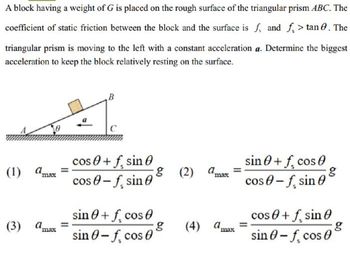Question

Transcribed Image Text:A block having a weight of G is placed on the rough surface of the triangular prism ABC. The
coefficient of static friction between the block and the surface is f, and f> tan. The
triangular prism is moving to the left with a constant acceleration a. Determine the biggest
acceleration to keep the block relatively resting on the surface.
B
(1) a
cos 0 +f, sin 0
-f sin
g (2) a
sin+f, cos
cos-f, sin
max
cos
sin+f, cos 0
cos+f, sin
(3) dmas
g
(4) a
sin 0-f, cos 0
sin 0-f, cos 0
max
max
g
Expert Solution
This question has been solved!
Explore an expertly crafted, step-by-step solution for a thorough understanding of key concepts.
Step by stepSolved in 2 steps with 2 images

Knowledge Booster
Similar questions
- Plz use g = 9.8 m/s2arrow_forwardⒸ Macmillan Learning An engineer wants to design an oval racetrack such that 3.20 × 10³ lb racecars can round the exactly 1000 ft radius turns at 96 mi/h without the aid of friction. She estimates that the cars will round the turns at a maximum of 175 mi/h. Find the banking angle necessary for the race cars to navigate the turns at 96 mi/h without the aid of friction. 0 = This banking and radius are very close to the actual turn data at Daytona International Speedway, where 3.20 × 10³ lb stock cars travel around the turns at about 175 mi/h. What additional radial force is necessary to prevent a race car from drifting on the curve at 175 mi/h? radial force: Narrow_forwardAsaparrow_forward
- 2. A two body system is set up on an inclined surface with M = 5 kg and m = 4 kg. The angle is 25 degrees. And the static frictional coefficient is 0.25, and kinetic frictional coefficient is 0.20. i. Find the parallel and perpendicular components of the Mg. ii. Find the static frictional force and kinetic frictional force. iii. Determine which way the system will move, uphill or downhill. iv. Once it starts, find the tension T =? v. Once it starts, find the acceleration, a=?arrow_forwardt Three blocks are connected by massless ropes that move without slipping over frictionless pulleys; the mass of block A is 1.4 kg, the mass of block C is 2.1 kg, and the mass of block B is 6.0 kg. Each pulley can be modeled as a uniformly dense cylinder with a mass of 4.0 kg. What is the magnitude of the tension (in N) in the rope between block A and the pulley? rd A 1 B C Type your answer... Submitarrow_forwardQ3. The refrigerator has a weight of 80 kg and rests on a tile floor for which u.= 0.25. also the man has a weight of 70 kg and the coefficient of static friction between the floor and his shoes is µ = 0.5. If he pushes horizontally on the refrigerator, determine if he can move it. If so. does the refrigerator slip or tip? Take g=10m/s² 1.0m 10 1.2m 0.5m A 1.0marrow_forward
arrow_back_ios
arrow_forward_ios